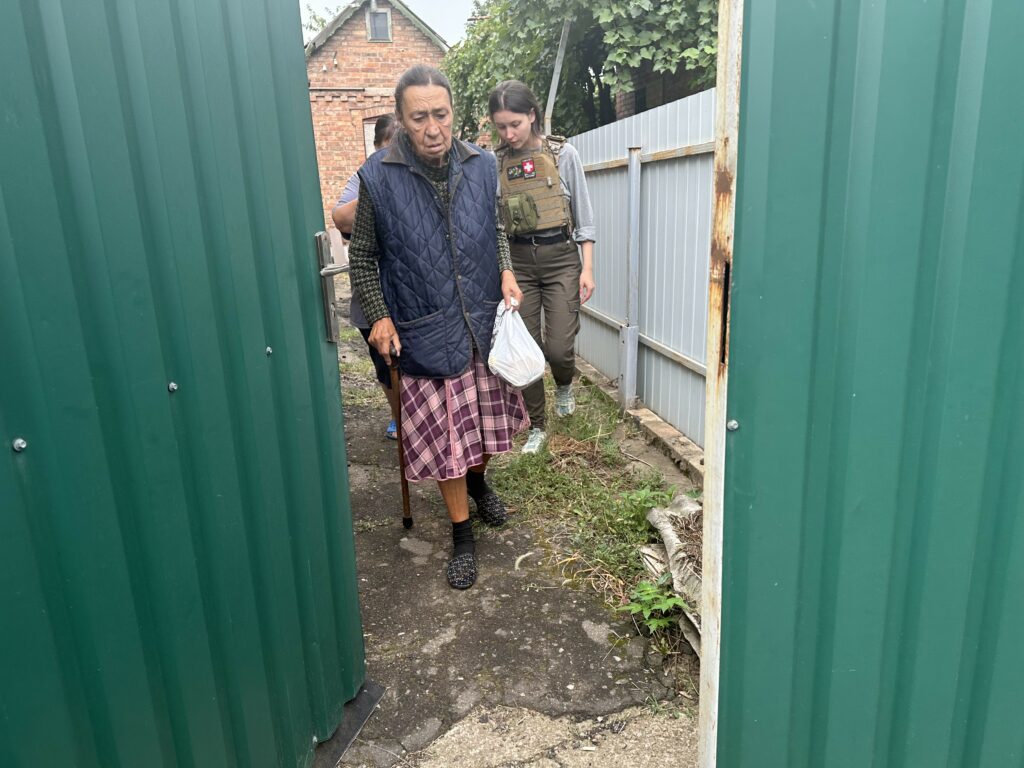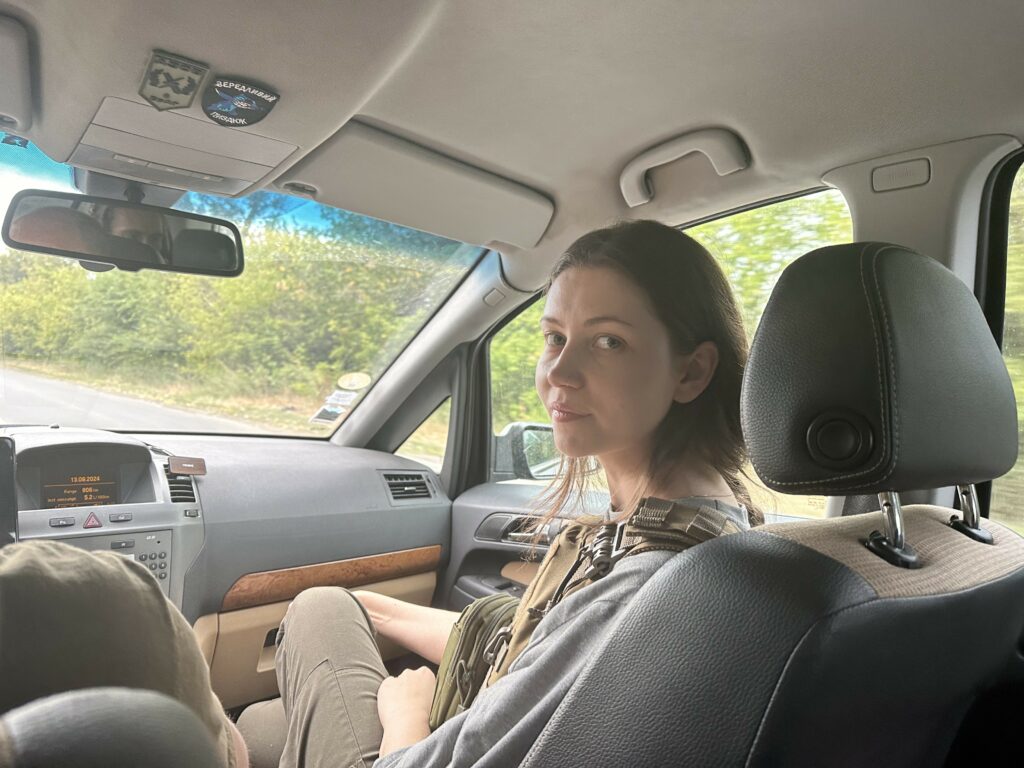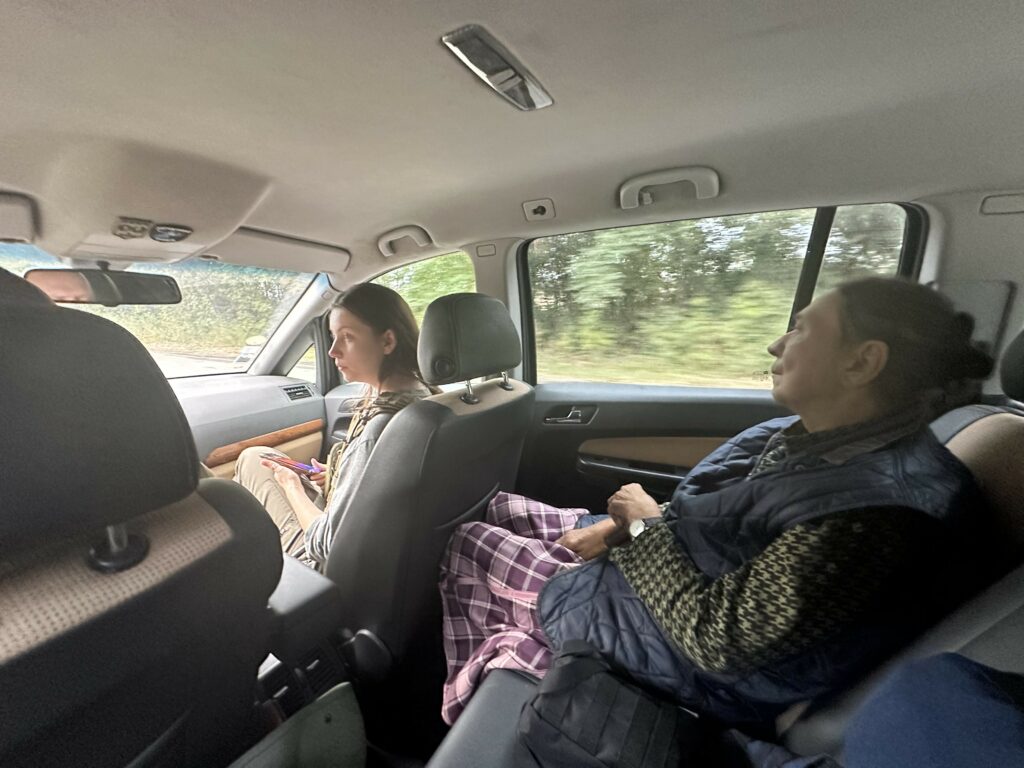The deeper the Russian army advances into Ukraine’s territory, the more destruction and suffering it causes to civilians. It looks like total devastation – the approach of Russians means certain death. Every day, people are forced to leave new and new places to escape enemy shelling. Leaving a frontline town or village is a tough challenge that people often cannot overcome alone. That’s when volunteers from different parts of Ukraine and the whole world come to help refugees. These people are aware of the danger they expose themselves to, but they continue their service anyway.
Halyna, 78, leaves her home in Kostiantynivka, the Donetsk region, with one bag – even the volunteers who evacuate her are surprised that she has so few things.
“It’s loud, both at night and in the morning. There’s also thunder,” says Halyna’s neighbor, who volunteers Marichka and Vitaliy kept in touch with (Halyna is hard of hearing). ‘Loud’ is, of course, about explosions. The frontline is a little more than 10 kilometers from Ukrayinska Street, where the woman is being evacuated, and one of the closest perpendicular streets is a direct road to Chasiv Yar, part of which has already been captured by Russian troops, and the center of which is 7-8 kilometers away.

While Halyna was getting into the car, and the volunteers were chatting with her neighbor, they heard an explosion. It’s really loud here.
“I’m deaf, I can’t hear anything,” says Halyna, when Marichka repeats several times that the passenger can ask to stop the car at any time if she needs to use the toilet or something else.
“I’m going to see my son in Kharkiv,” the woman says when we try to talk to her in the car.
Marichka and Vitaliy say that the number of evacuations has dramatically grown recently, as the frontline is approaching and Russian shelling of frontline towns in the Donetsk region is intensifying.
For example, Russians target Kostiantynivka, which Halyna left, several times a day with artillery and aerial bombs, and people die or are injured daily. Two days before Halyna’s evacuation, three people were killed as a result of shelling, two were wounded the next day, and a few hours after the volunteers took out their ward, the Russians shelled Kostiantynivka with artillery and hit a high-rise building, killing a 43-year-old woman in her kitchen.
Banks, government institutions, and shops suspend operations in Kostiantynivka because the security situation deteriorates and the staff is evacuated. For example, it was recently announced by the local service center of the Pension Fund. You rarely meet people on the town streets now: the volunteers drove all across Kostiantynivka to pick up Halyna and met only four people, three of them looking like pensioners, and one looking like a homeless person.
“For the last few days, we’ve been evacuating daily. Families with children leave more often. Recently, a fellow volunteer took an injured woman and a child from Kostiantynivka to a rehabilitation center in Kropyvnytskyi. Some time ago we evacuated a woman and five children, one of whom was about eighteen months old,” says Marichka Semanyshyn, a Roads of Life volunteer. This is a project of the Vsi Poruch charity foundation from Kramatorsk, implemented in cooperation with the Nonviolent Peaceforce, KIWI KARE, and Day By Day foundations. The Roads of Life says that they have already evacuated over two thousand people.

Volunteers are evacuating people from Pokrovsk, Ukrayinsk, Hirnyk, Kostiantynivka and other towns of the Donetsk region, where the frontline has come close. Vitaliy says that evacuees mainly go to the Dnipropetrovsk and Kharkiv regions or to Kropyvnytskyi.
“They go where they have relatives or friends, or where they can find housing. Sometimes they ask if we can help [with housing]. Then we call shelters, make arrangements. We have a girl who deals with this issue,” he says.
Vitaliy Zuev is from Kramatorsk, and before the big war he worked as a taxi driver, then in an electrical shop, and when the full-scale Russian invasion broke out, he began working for the Vsi Poruch charity foundation. For the past six months, he has been engaged in evacuation, working as a driver, and when he drives a social taxi, he also helps to carry out the sick.
“Now danger is close to us all, but yes, this [evacuation from frontline towns] is more dangerous. But someone has to do it,” he says.
Before entering Kostiantynivka, the volunteers stop at the roadside: while Marichka puts on a bulletproof vest, Vitaliy smokes.
“If it hits, the vest won’t save us,” he says. “But she’s scared, so let her wear it.”
Marichka calls herself ‘the most frightened’ among all the charity staff. She says that as soon as someone slams the door, she grabs the first-aid kit and looks for a place in the room behind two walls. The night before there was loud thunder and rain, the volunteer laughs and says that she spent the whole night in the corridor.
“I’m scared; I’m one of those who are most afraid. But it doesn’t affect my motivation, I want to be at home and I don’t want my home to be taken away,” she says.
Marichka is not from the Donetsk region. She’s from Kalush, the Ivano-Frankivsk region. Before the big war, she lived in London and worked as a nanny – first in an English-speaking family, then in a Ukrainian family that had moved to the UK because of the war. Overall, she spent about two years there. She returned to Ukraine for the first time in the summer of 2022 – she went to the Mykolayiv region to restore Voznesensk, where in the spring of 2022, there were battles between Ukrainian and Russian troops that ended in the victory of the Ukrainians.
After a while, Marichka returned to London, and six months later she went to Ukraine again, but this time to Sloviansk, the Donetsk region, where she started working as a translator and evacuator in the international charity organization Road to Relief. In September 2023, during an evacuation trip to Bakhmut, the director of this NGO Emma Igual and volunteer Anthony Ignat were killed, and two more volunteers ended up in hospital when their car was shelled by the Russians. After that, Marichka returned to London once again, and this June she came to Kramatorsk intending to stay in Ukraine.
“I never went to London planning to live there. It was my job, and it was not the job I wanted to do. I always wanted to return to Ukraine, and when the full-scale war began, I realized that I would work where I was needed, I’d develop in Ukraine, and I’d return to London as a second home, to see my friends, all close people, but I’d stay in Ukraine,” Marichka explains her motivation.

We say goodbye to Marichka, Vitaliy and their ward Halyna in the frontline but safer Kramatorsk. Then they head to Kharkiv. Marichka does not take off her bulletproof vest.
Author: Oleksiy Ladyka
*All photos are provided by the author.
Supported by the U.S. Embassy in Ukraine. The views of the authors do not necessarily reflect the official position of the U.S. Government.



